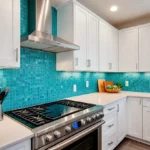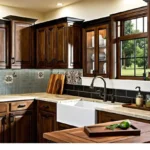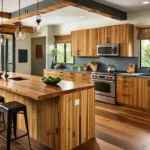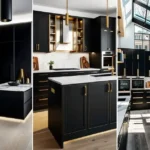Kitchens are notorious for mold formation and it is not just the ugly sight that is displeasing; it poses health hazards and your house may be at risk. Mold prone areas are usually warm, moist and frequently used and all these attributes make the kitchen a preferred place for mold development.
Application of intervention measures aimed at elimination of mold is critical to eliminating mold problems as well mitigating the negative impacts on the quality of the air we breathe in our homes. This guide will provide valuable strategies for removing mold in the kitchen, control outdoor mold sources, and guaranteeing safe and effective kitchen wall mold remediation.
Pro Tips for Removing Mold in the Kitchen | THE INSIDE DECOR
Here are details about the kind of mold that is most likely to affect the kitchen and the materials you will need to deal with it to completion. It will give you detailed measures that you should embrace in order to avoid mold and other tactics that can be used in maintaining hygiene. Also, you will be able to understand mold problems that emanate from the outside and their effects on IAQ.
The guide also covers step-by-step methods for safely removing mold in the kitchen, ensuring that you can address any existing problems efficiently and prevent future occurrences. When implemented in your day to day life, you will be able to keep your kitchen in a healthy and free from molds status by following the above tips from the experts.
Understanding Mold
Mold requires warm and wet conditions to grow and since a kitchen is usually warm and has a lot of moisture from steam and water, mold growth is common in the kitchen. The major causes of formation of mold include humidity, water leakage and inadequate air circulation. Key areas where mold is commonly found include:-
- Under the kitchen sink, where leaks and spills are frequent.
- Inside kitchen cabinets, particularly if they are exposed to high humidity or water.
- On kitchen cabinet molding and trim, which can trap moisture.
- Around kitchen windows, where condensation can occur.
- On crown molding for the kitchen and other kitchen molding ideas.

Preventing Mold Growth in the Kitchen
1. Control Moisture Levels
- Fix Leaks: Regularly inspect pipes, faucets, and appliances for leaks. Even minor drips can contribute to mold growth. Repair any leaks promptly to prevent water accumulation.
- Proper Ventilation: Make sure there is enough ventilation in your kitchen. Use exhaust fans when cooking to reduce humidity levels. Open windows and doors when possible to allow fresh air circulation.
- Dry Wet Areas: After spills or cooking, promptly clean and dry surfaces. This includes countertops, floors, and sink areas.

Related – 10 Powerful Ways to Get Rid of Ants in Your Kitchen Naturally
2. Maintain Low Humidity
- Use Dehumidifiers: In areas prone to high humidity, such as kitchens without proper ventilation, consider using a dehumidifier to keep moisture levels in check.
- Monitor Humidity Levels: Aim to keep indoor humidity below 60%. Humidity monitors are inexpensive and can help you keep track of indoor conditions.

3. Regular Cleaning and Maintenance
- Clean Spills Immediately: Wipe up any spills or water leaks promptly to prevent moisture from settling.
- Inspect and Clean Kitchen Cabinets: Regularly check inside kitchen cabinets and clean them to remove any mold spores that might be developing.
- Maintain kitchen cabinet molding: Ensure that kitchen cabinet molding is dry and free from moisture. Regularly check these areas for signs of mold.

4. Proper Storage
- Store Food Properly: Avoid leaving food uncovered or in humid areas. Store food in airtight containers to prevent mold spores from settling on it.
- Keep Pantry Dry: Ensure your pantry remains dry and well-ventilated. Use silica gel packets or moisture absorbers if necessary.
Managing Mold Outdoors
Outdoor mold can impact indoor air quality when spores are carried inside. Here’s how to manage it:
1. Maintain Exterior Surfaces
- Clean Gutters Regularly: Such walls have dilapidated gutters which if blocked cause water damage to the interior walls and the development of mold on the exterior part. This is a true because gutters and downspouts accumulates water and if not well maintained, the water penetrates into the house.
- Inspect Roof and Siding: Check your roof and siding for damage or moss growth. Seal any damages immediately to avoid the penetration of water.
2. Landscaping Considerations
- Ensure Proper Drainage: Grade your yard so that water drains away from your home’s foundation. Avoid planting bushes or trees too close to the house to prevent moisture buildup against the walls.
- Keep Landscaping Dry: Avoid overwatering plants near your home’s exterior, as excess moisture can contribute to mold growth.
Removing Mold from Kitchen Walls

If mold does appear on your kitchen walls, prompt and thorough removal is crucial to prevent further growth and potential health issues.
1. Safety Precautions
- Protect Yourself: Wear protective gear, including gloves, goggles, and an N95 respirator mask to avoid inhaling mold spores.
- Ensure Ventilation: Open windows and doors to improve airflow and reduce exposure to mold spores.
2. Cleaning Moldy Surfaces
- Identify the Type of Mold: Most kitchen molds are black or green and can be cleaned with common household products. If the mold is extensive or you are unsure, consider consulting a professional.
- Clean Small Areas:
- Mix a Cleaning Solution: Combine water with a small amount of dish soap or a specialized mold cleaner.
- Scrub the Surface: Using a sponge or cloth, gently scrub the moldy area until it is clean. Avoid using abrasive materials that might damage the wall.
- Rinse and Dry: Rinse the area with clean water and dry it thoroughly to prevent mold from returning.

3. Dealing with Extensive Mold
- Remove and Replace Affected Materials: For extensive mold growth, particularly on porous materials like drywall, removal and replacement might be necessary. Cut out and discard the affected sections of drywall, ensuring that the underlying studs are dry and mold-free before installing new drywall.
- Use Mold-Resistant Products: When replacing materials, consider using mold-resistant drywall and paint to help prevent future issues.

4. Professional Help
- Consult Professionals: If you find that mold is present throughout your house or it comes back despite the efforts you have made, then it is wise you consult a mold removal specialist. They have the equipment and know-how on how to safely and efficiently deal with large mold problems.

Tips for Safe Mold Removal
- Avoid Bleach for Porous Surfaces: While bleach is effective on non-porous surfaces, it may not penetrate deeply enough into porous materials like wood or drywall to fully remove mold. For these surfaces, opt for specialized mold removers or natural solutions.
- Use Natural Cleaners: For those sensitive to chemicals or seeking eco-friendly options, natural mold cleaners like vinegar or baking soda can be effective. Vinegar can kill most types of mold, while baking soda helps to absorb moisture and odors.
- Dispose of Contaminated Materials Properly: Seal moldy materials in plastic bags before disposing of them to prevent spores from spreading.
- Monitor and Maintain: After removal, continue to monitor the area for signs of mold return. Regularly clean and maintain the kitchen to ensure that mold does not reappear.
Frequently Asked Questions (FAQs)
1. Do Home Inspectors Check for Mold?
Yes, do home inspectors check for mold? Many home inspectors do check for signs of mold, but it depends on the scope of the inspection. If you suspect mold, it’s a good idea to specifically request a mold inspection.
2. How Can I Prevent Mold in Kitchen Cabinets?
To prevent mold in kitchen cabinets, ensure they are well-ventilated and dry. Regularly inspect them for moisture and use mold-resistant liners if needed.
3. What Are Some kitchen cabinet base molding ideas to Prevent Mold?
Consider installing light rail molding or other easy-to-clean kitchen cabinet molding and trim that is less likely to trap moisture. Choosing kitchen cabinet base molding that promotes air circulation can also help prevent mold growth.
4. How Do I Remove Mold from Kitchen Sink?
To remove kitchen sink mold, scrub the affected area with a mixture of water and vinegar. Ensure the sink is dried thoroughly to prevent mold from returning.
5. What Are the Best kitchen molding ideas for Preventing Mold?
Kitchen molding ideas that include using mold-resistant materials and ensuring proper sealing can help prevent mold. For example, oak crown molding for kitchen cabinets can add both aesthetic value and functionality if maintained properly.
Conclusion
Preventing and Removing Mold in the Kitchen, it is necessary to have a strategy which includes; Control of Moisture, cleaning and maintenance and Immediate action, if there is Mold Growth. Following the recommendations given in this guide, one can prevent the formation of mold and maintain proper living conditions in the kitchen. If there is a moisture or mold problem in the home correct it quickly and effectively so as to not further harm the living environment. Enough monitoring of the kitchens and appropriate cleanliness and maintenance practices will be very helpful in avoiding the formation of molds in our kitchens.









